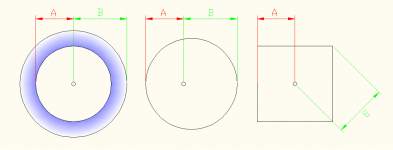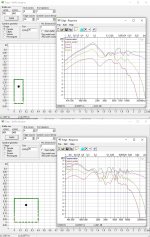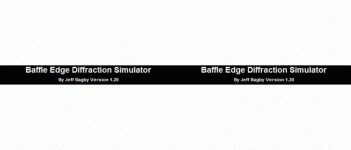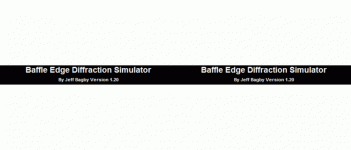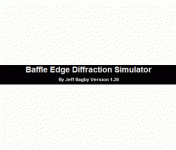You are right Ron, i should read up on the basics a bit more. I am clearly not able to ask the right question, or maybe i just havent understood the answer.
There is a lot of good information in this thread now, thanks to everyone who have contributed to that. I will do some reading and come back when i have formulated my question better.
There is a lot of good information in this thread now, thanks to everyone who have contributed to that. I will do some reading and come back when i have formulated my question better.
Last edited:
Another key compounding factor is that most people think of diffraction as defined by its effect upon axial response- when it's really more of a spread-spectrum comb filtering behavior. Hence it's less tonal shift than one might expect, and more about creating a secondary, incoherent soundfield that belies the location of the speaker. Low diffraction speakers tend to do a much better job of that "holographic" thing we hear so much about.
Regarding management, there's definitenly more than one way to skin a cat- Apart from absorption (felt/foam collars, etc) one can either minimize baffle size relative to driver diameter to mitigate diffraction by virtue of transducer directivity (which puts the baffle step as high in frequency as possible) or use large baffles with substantial roundovers or bevels. The same tradeoffs are true with dipoles though there's some (slight) added complexity. With horns, terminate the mouth either with absorption or a secondary flare.
Regarding management, there's definitenly more than one way to skin a cat- Apart from absorption (felt/foam collars, etc) one can either minimize baffle size relative to driver diameter to mitigate diffraction by virtue of transducer directivity (which puts the baffle step as high in frequency as possible) or use large baffles with substantial roundovers or bevels. The same tradeoffs are true with dipoles though there's some (slight) added complexity. With horns, terminate the mouth either with absorption or a secondary flare.
Ron, I'm having a problem with your assertions about putting the driver in the middle. The three baffles here want to diffract the same amount. In each case the diffraction is spread in time between distance A and distance B.ANY baffle has diffraction; whether the response is smooth or not is another story. You don't even have to get very complex with baffle shape (like the 1x1m punched out of a 2m diameter sphere I mention above) before the response is non-trivial to calculate. If your driver is in the geometric center, it will have ripples even in that. At 1m wide, they will start around 300Hz....
Since your argument is based on pressure, wouldn't spatial distribution (including versus time) be the significant difference?
Attachments
Last edited:
Neil said in post #36 that baffle width does affect directivity. I made some more simulations with BDS and Edge to look at that.
In my eyes,
1) baffle width does not affect directivity (understood as attenuation of response of high F)
2)baffle interference ripples are not similar at various angles
3) If the driver is offset, left and right off-axis response are not similar.
In my eyes,
1) baffle width does not affect directivity (understood as attenuation of response of high F)
2)baffle interference ripples are not similar at various angles
3) If the driver is offset, left and right off-axis response are not similar.
Attachments
Neil said in post #36 that baffle width does affect directivity. I made some more simulations with BDS and Edge to look at that.
In my eyes,
1) baffle width does not affect directivity (understood as attenuation of response of high F)
2)baffle interference ripples are not similar at various angles
3) If the driver is offset, left and right off-axis response are not similar.
I think your graphs are consistent with what I said. Your Edge charts model the ripples that are a result of radiation from the edge of the baffle. These ripples are directional--for a given frequency, they vary in intensity depending on the listening angle. The nulls and peaks aren't anywhere as steep as what you get from driver directivity because the amount of radiation from the baffle is much less. But still, there is at least some loudspeaker directivity due to the radiation from the baffle.
Baffle size and shape do not affect directivity of a driver (except for horns). The diameter of the driver and radiating surface topology (dome, planar, concave) make that.
In general, I don't know if there is a simulator for round/bended/multiform baffle contour. BDS can not use other than rectangular baffle (4 corners) and Edge an not use rounded edges.
So if I place a tweeter to the left on a baffle, it will measure the same 30 deg from left as from 30 deg right?
//
Yes. The baffle also holds the output in half space, and the lower frequencies will widen to full space.Baffle size and shape do not affect directivity of a driver (except for horns).
So if I place a tweeter to the left on a baffle, it will measure the same 30 deg from left as from 30 deg right?
//
No, not at all same, if the driver is not at midline.
See my previous post with simulations with BDS, for narrow and wide cab. In both animations, the graph on left microphone is offset to the left and right is to the right side
My simulations were all with 1" driver which means a tweeter. 0, 15,30,45 and 60¤ angles. This is where the challenge lies.
Here is a 6,5" midwoofer in the middle of a 10" wide baffle with sharp edges. We can't see any edge diffraction ripples, just the directivity behaviour!
Attachments
Last edited:
- Status
- This old topic is closed. If you want to reopen this topic, contact a moderator using the "Report Post" button.
- Home
- Loudspeakers
- Multi-Way
- Baffle edge diffraction vs baffle step
